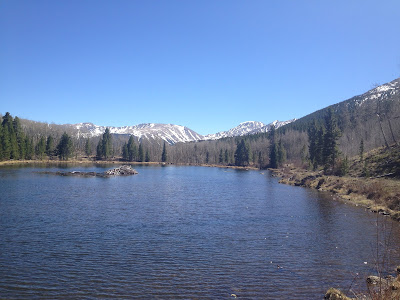Given the course's impressive amount of vertical (5,500 ft of climbing) it will probably fall somewhere between the Salida marathon and the Leadville marathon in terms of difficulty-- probably closer to Salida.
QR25 vs. CPTR (4:34)
- QR25 is 2,500 ft lower in elevation.
- QR25 has 2,000 ft more elevation gain.
- I'm in approximately the same shape as late April.
QR25 vs. Salida (5:34)
- QR25 is 1.2 miles shorter.
- QR25 is 2,000 ft lower in elevation.
- QR25 has 1,000 ft more elevation gain.
- QR25 will be snow free!
- I'm in much better shape now than in early March.
QR25 vs. Leadville (5:49)
- QR25 is 1.2 miles shorter.
- QR25 is 5,000 ft lower in elevation.
- QR25 has 500 ft less elevation gain.
- QR25 has gotta have fewer rocks than Mosquito Pass.
- I'm probably not in better shape now than I typically am in early July.
So... I don't know. I'd be thrilled with a 4:59 finish, but I think that's a little optimistic. More realistic would be something like 5:10ish. The big unknown for me is how much the lower elevation will cancel out the extra climbing. The lower elevation has gotta count for something-- the race is 5,000 ft lower than my average training run!-- but climbing is climbing. It's always tough and the QR25 has plenty of it. Another X factor would be the potential heat in Ft. Collins, but the weather actually looks perfect for Saturday's race-- a relatively cool 65F. I'm not tapering for the race, but the only race I do taper for is the 100, so that shouldn't really be a factor when comparing times.
My strategy will be what it pretty much always is:
I've gotten in some solid training since CPTR two weeks ago. I enjoyed a beautiful 20 mile run around Twin Lakes last Friday-- completely snow free! The heat and sun definitely crept up on me and I became seriously dehydrated just before the epic 2,000 ft climb up to Lily Ponds at mile 14. It was a grind, but a good opportunity to practice my power hike. I finished the run weighing 5 lbs less than my starting weight-- not good. Every year it seems I need a reminder to drink, dammit! I try to consume 20 oz of water an hour, but sometimes I get lazy and pay the price. I find that each long training run has a lesson to teach you-- though it may not be the lesson you expected.
My strategy will be what it pretty much always is:
- Start slow and steady.
- Focus on nutrition and hydration. Eat! Drink!
- Power hike the steep uphills. Run the downhills.
- Have fun!
- Try to finish strong.
 |
| The trail around Twin Lakes is totally melted out. |
I've gotten in some solid training since CPTR two weeks ago. I enjoyed a beautiful 20 mile run around Twin Lakes last Friday-- completely snow free! The heat and sun definitely crept up on me and I became seriously dehydrated just before the epic 2,000 ft climb up to Lily Ponds at mile 14. It was a grind, but a good opportunity to practice my power hike. I finished the run weighing 5 lbs less than my starting weight-- not good. Every year it seems I need a reminder to drink, dammit! I try to consume 20 oz of water an hour, but sometimes I get lazy and pay the price. I find that each long training run has a lesson to teach you-- though it may not be the lesson you expected.
 |
| They've also replaced the footbridge on the west side of Twin Lakes. (It was washed out last year.) |
 |
| A view of Hope Pass from Lily Ponds. I bet the CT from Twin to Halfmoon is runnable! |
Thanks for the Twin Lakes pics. I was up last weekend and ran the northern parts of the course. Need to get down to Hope Pass soon too.
ReplyDeleteNo problem, Brandon. I haven't been up the Powerlines yet this season, so your photos were helpful too. The south side of Hope Pass may be getting close to runnable... but the north side probably needs a few more weeks of sunshine. It all depends on how much post holing you want to do!
ReplyDelete